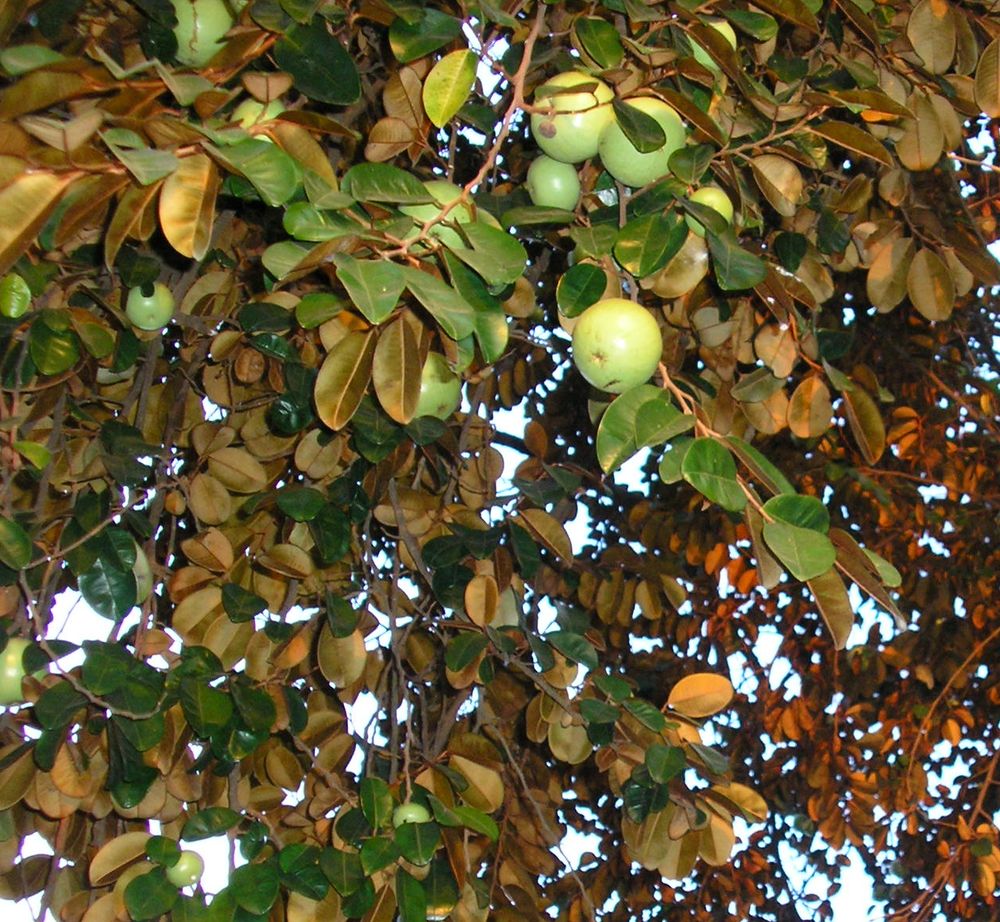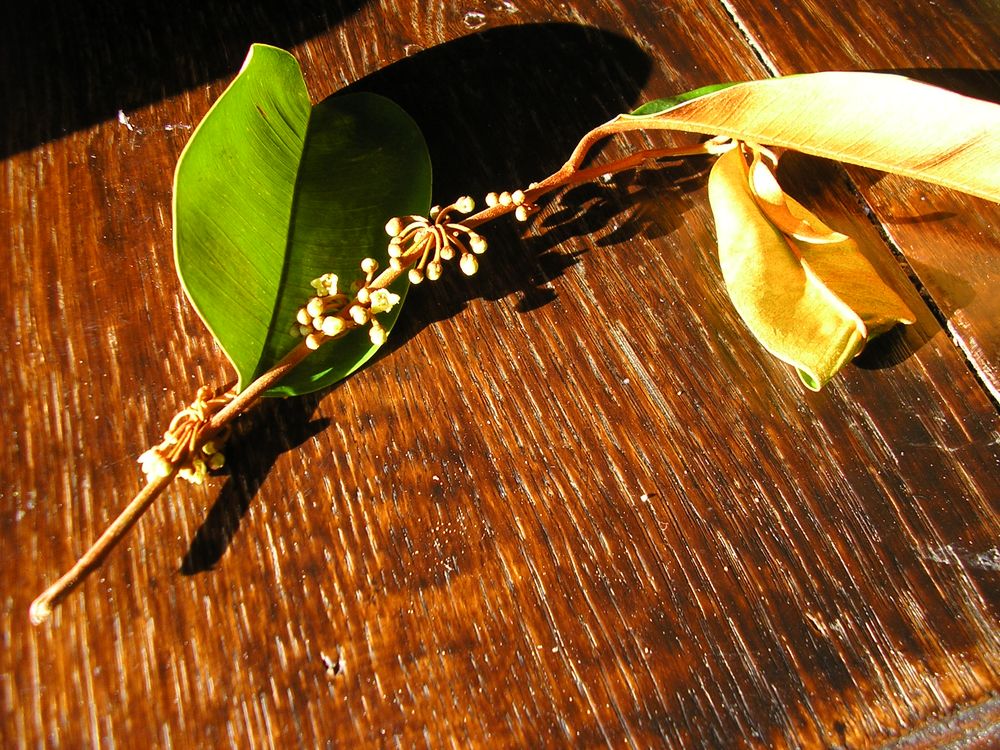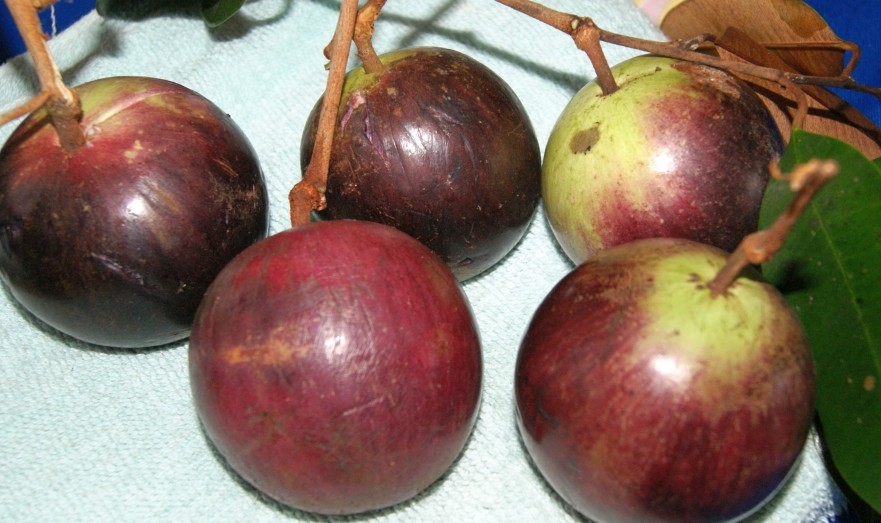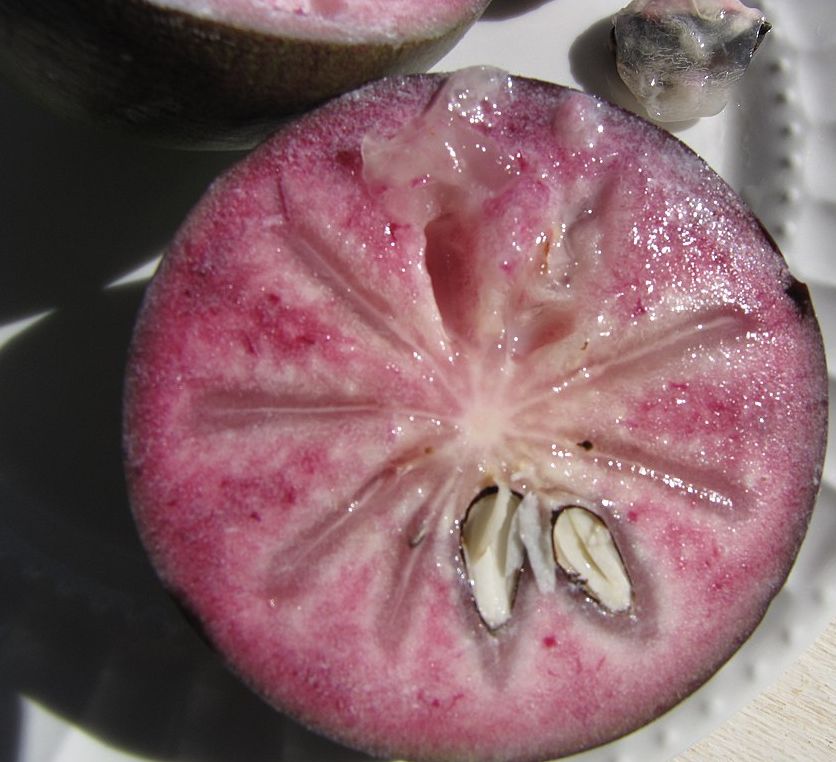The Star Apple Tree is a large tree remarkable for its green and shiny leaves on one side, copper on the other; we see many plants in the gardens in Vientiane. The fruit, Star Apple, is a large, globose berry that is deep purple when ripe; other varieties stay green or turn brown. The thick skin of the fruit contains a white sap that sticks to the lips when eaten; this feature gave the plant the Lao (and Cambodian) name: mak nam nom, “milk fruit”; the English language has especially noticed the fact that the cross section of the fruit draws a star, as for the French it retains the Native American name of this fruit from America. The fruit whose pulp contains brown and hard seeds is delicious but seems little appreciated in Laos if we judge by the fact that few are offered on the markets and that they sometimes rot on the tree.
Le Caïnitier est un grand arbre remarquable par ses feuilles vertes et luisantes d’un côté, cuivrées de l’autre; on en voit de très nombreux pieds dans les jardins à Vientiane. Le fruit, la Caïnite, est une grosse baie globuleuse d’un violet profond à maturité; d’autres variétés restent vertes ou brunissent. La peau épaisse du fruit contient une sève blanche qui colle aux lèvres lorsqu’on le mange; cette caractéristique a donné le nom lao (et cambodgien) de la plante: mak nam nom, « fruit lait »; la langue anglaise a surtout remarqué le fait que la coupe transversale du fruit dessine une étoile, quant au français il retient le nom amérindien de ce fruit venu d’Amérique. Le fruit dont la pulpe contient des graines brunes et dures est délicieux mais semble peu apprécié au Laos si l’on en juge par le fait que peu sont proposés sur les marchés et qu’ils pourrissent parfois sur l’arbre.




The Star Apple Tree is a large tree remarkable for its green and shiny leaves on one side, copper on the other; we see many plants in the gardens in Vientiane. The fruit, Star Apple, is a large, globose berry that is deep purple when ripe; other varieties stay green or turn brown. The thick skin of the fruit contains a white sap that sticks to the lips when eaten; this feature gave the plant the Lao (and Cambodian) name: mak nam nom, “milk fruit”; the English language has especially noticed the fact that the cross section of the fruit draws a star, as for the French it retains the Native American name of this fruit from America. The fruit whose pulp contains brown and hard seeds is delicious but seems little appreciated in Laos if we judge by the fact that few are offered on the markets and that they sometimes rot on the tree.
Le Caïnitier est un grand arbre remarquable par ses feuilles vertes et luisantes d’un côté, cuivrées de l’autre; on en voit de très nombreux pieds dans les jardins à Vientiane. Le fruit, la Caïnite, est une grosse baie globuleuse d’un violet profond à maturité; d’autres variétés restent vertes ou brunissent. La peau épaisse du fruit contient une sève blanche qui colle aux lèvres lorsqu’on le mange; cette caractéristique a donné le nom lao (et cambodgien) de la plante: mak nam nom, « fruit lait »; la langue anglaise a surtout remarqué le fait que la coupe transversale du fruit dessine une étoile, quant au français il retient le nom amérindien de ce fruit venu d’Amérique. Le fruit dont la pulpe contient des graines brunes et dures est délicieux mais semble peu apprécié au Laos si l’on en juge par le fait que peu sont proposés sur les marchés et qu’ils pourrissent parfois sur l’arbre.








The Star Apple Tree is a large tree remarkable for its green and shiny leaves on one side, copper on the other; we see many plants in the gardens in Vientiane. The fruit, Star Apple, is a large, globose berry that is deep purple when ripe; other varieties stay green or turn brown. The thick skin of the fruit contains a white sap that sticks to the lips when eaten; this feature gave the plant the Lao (and Cambodian) name: mak nam nom, “milk fruit”; the English language has especially noticed the fact that the cross section of the fruit draws a star, as for the French it retains the Native American name of this fruit from America. The fruit whose pulp contains brown and hard seeds is delicious but seems little appreciated in Laos if we judge by the fact that few are offered on the markets and that they sometimes rot on the tree.
Le Caïnitier est un grand arbre remarquable par ses feuilles vertes et luisantes d’un côté, cuivrées de l’autre; on en voit de très nombreux pieds dans les jardins à Vientiane. Le fruit, la Caïnite, est une grosse baie globuleuse d’un violet profond à maturité; d’autres variétés restent vertes ou brunissent. La peau épaisse du fruit contient une sève blanche qui colle aux lèvres lorsqu’on le mange; cette caractéristique a donné le nom lao (et cambodgien) de la plante: mak nam nom, « fruit lait »; la langue anglaise a surtout remarqué le fait que la coupe transversale du fruit dessine une étoile, quant au français il retient le nom amérindien de ce fruit venu d’Amérique. Le fruit dont la pulpe contient des graines brunes et dures est délicieux mais semble peu apprécié au Laos si l’on en juge par le fait que peu sont proposés sur les marchés et qu’ils pourrissent parfois sur l’arbre.


